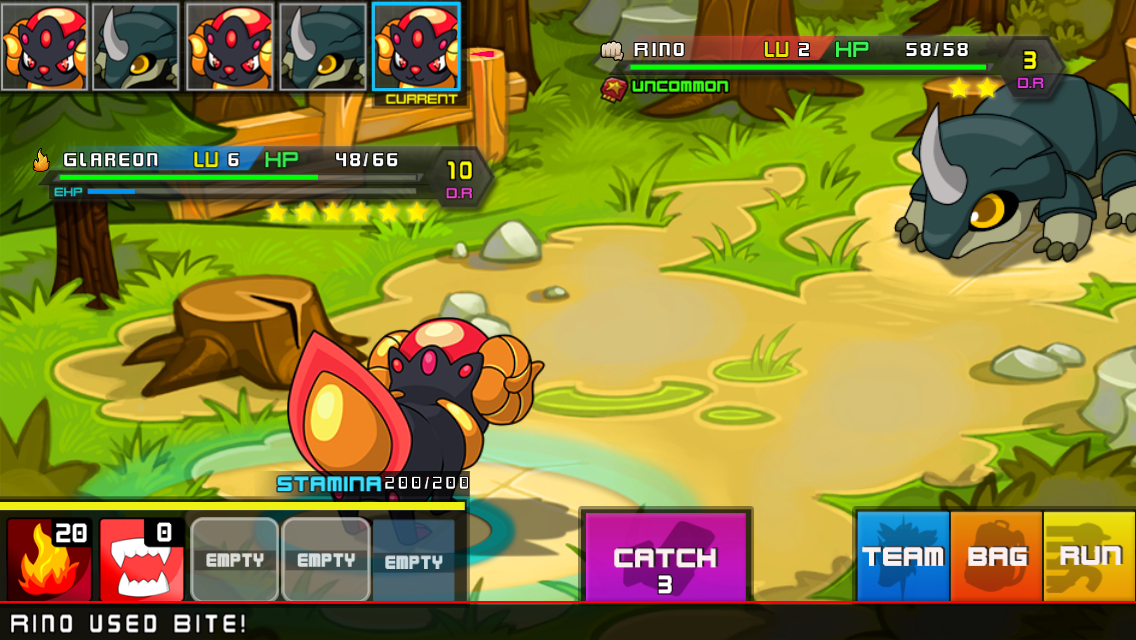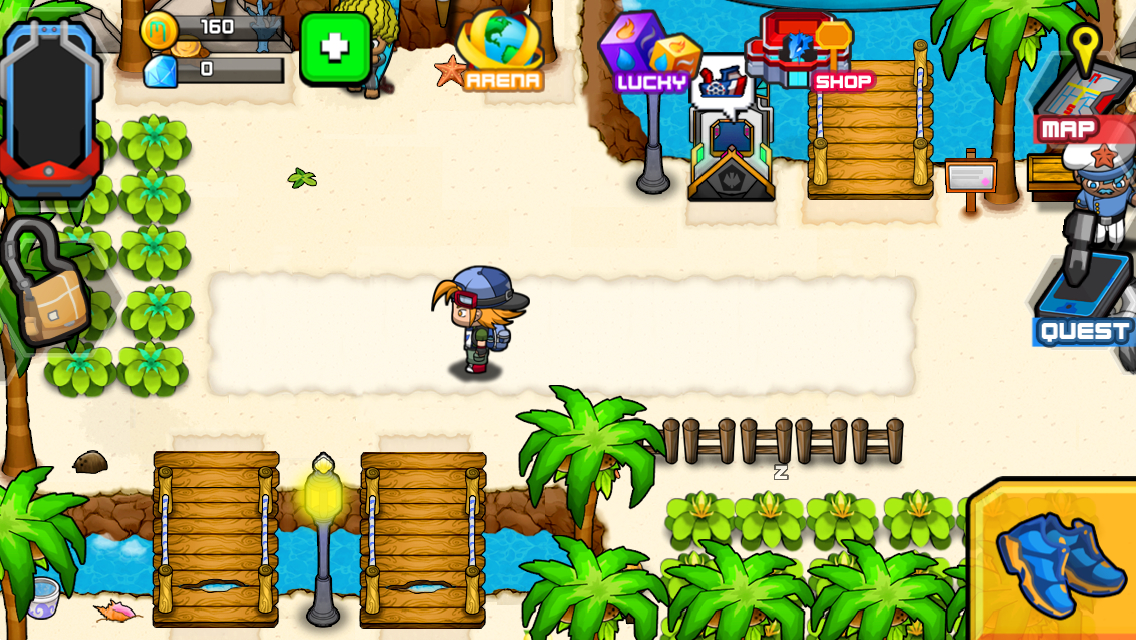![]() Pokemon clones are by no means a new thing. With as much success as Nintendo’s monster-catching RPG has enjoyed, clones are simply an expected part of doing business. They’re not even a new thing for iOS. I’ve reviewed both Hunter Island ($0.99) and Band of Monsters (Free) in the last year, to say nothing of the many Puzzle & Dragons (Free)-inspired games released that borrow liberally from Pokemon. That said, with all of the clones, homages, parodies, and more that I’ve played over the years, none have skated quite so closely to Pokemon‘s game design as Micromon ($0.99). There’s little pretense about what they’re doing here, with cheeky references all over the place and gameplay that is certainly the spitting image of Pokemon imagined as a $0.99 mobile game. Well, originality isn’t everything.
Pokemon clones are by no means a new thing. With as much success as Nintendo’s monster-catching RPG has enjoyed, clones are simply an expected part of doing business. They’re not even a new thing for iOS. I’ve reviewed both Hunter Island ($0.99) and Band of Monsters (Free) in the last year, to say nothing of the many Puzzle & Dragons (Free)-inspired games released that borrow liberally from Pokemon. That said, with all of the clones, homages, parodies, and more that I’ve played over the years, none have skated quite so closely to Pokemon‘s game design as Micromon ($0.99). There’s little pretense about what they’re doing here, with cheeky references all over the place and gameplay that is certainly the spitting image of Pokemon imagined as a $0.99 mobile game. Well, originality isn’t everything.
As the game starts, you get sucked into a digital world, Captain N-style, through your mobile device. In this world, people collect, train, and battle with monsters called Micromon. After a brief prologue, your goals are made clear. You have to collect as many Micromon as you can, defeat the four town heroes, and maybe take on some bad guys along the way. You’re basically on a road trip from town to town, with the routes between each town filled with Micromon lurking in the tall grass. Sometimes you’ll go into a cave or something. It’s Pokemon, guys and gals. Get out there, catch some monsters, train up your favorites, and take on all comers. Then, when your team is where you want it, go play against some human opponents to really test your skills. There’s a story here, but like the one found in Pokemon, it doesn’t matter very much at all.

I could go into all the ways Micromon is like Pokemon, but there’s not a lot of point to it, I think. If you’re looking for an iOS game with the general feel of Pokemon, that’s what you’ll find here. The gameplay structure, the battles, the capture mechanic, and the monster development are all very similar to that game. Like a color copy of a painting, it’s not quite up to the original, with balance issues, bugs, and a relatively short quest with a serious lack of post-game content, but for its price, it’s kind of ridiculous how close this is to the real thing. In cases like this, I feel like it’s more useful to go into what’s different about the game, and a lot of that comes down to two things: simplification and monetization.
I think, if you’re reading this review, it’s very likely that you have played a Pokemon game before. You may have even cleared the main stories and battled a bit against friends. For most of you, you probably did all of this without realizing just how absurdly complicated the game design is under the hood. One of the things that has helped Pokemon thrive for as long as it has is that the games have some serious hidden depth to them. The best thing about that depth is that it’s there if you want to explore it, but if you don’t, it will never so much as make a peep, let alone sit you down and force you to learn it. You may have heard of or even engaged in things like IV breeding, which essentially involves manipulating the random individual values assigned to each particular Pokemon to produce super-powerful offspring. For the layperson, the main outcome is that each individual Pokemon is a little bit different from the next, so your Pikachu at level 15 might look a little different from your friend’s Pikachu at the same level. It’s a fun way to give the player a bit of ownership without causing major disruptions to the game balance, unless you min-max like crazy.

Micromon has something similar to IVs, but they’re quite different in practice. Each monster you earn or fight has a DR, or development ranking, from one to ten, with one being the lowest and ten being the highest. The higher that number is, the greater your monster’s stat gains with each level will be. At low levels, it makes for a fairly negligible difference, but as levels stack up, there’s a tremendous spread in power between lower DR and higher DR versions of the same monster. So even if you find that super-rare monster out in the wild, if its DR rank is low, it’s not worth nearly as much to your team. It’s very simple and straightforward, but it serves the same functional purpose as Pokemon‘s IVs. It creates somewhat individualized versions of the same monster and gives the hardcore players something to work for, without getting in the way of people who just want to make it through to the end of the game. Of course, you don’t have to worry about DR ranks if you just pull monsters using golden eggs.
That brings us to the other big difference in Micromon. If the low price seems too good to be true, well, those of you who aren’t so keen on IAP may want to shield your eyes. Similar to the indirectly-related Hunter Island, Micromon has quite a few IAP options for those looking to spend money to get ahead. You can buy two types of currency with your real money, the standard coins and the extremely rare diamonds. Coins are earned at a nearly-reasonable pace during battles, while you’ll only be given a particular number of diamonds during the course of the single player game, with more earned at a terrifyingly poor rate from the multiplayer arena battles.

With diamonds in hand, you can spend on a wide variety of things. You can purchase silver or gold eggs that can be used to pull a monster of a guaranteed minimum rarity, buy gold chips that help you catch monsters more easily, or buy new looks for your avatar. You can also use your diamonds to enter special areas with really awesome monsters to catch, but you’re on a very brief timer if you choose to do this. While I felt strapped for coins early on in the game due to spending so many on chips to catch monsters, for the most part, I had no trouble putting together a solid team for the single-player mode without buying any diamonds, and you can indeed catch all 137 monsters without putting in an extra cent. The single-player mode also yields a decent number of free eggs as you play, so it’s not stingy by any means.
My concern here comes with the multiplayer mode. You can battle people over the Internet, and obviously, the person with the stronger team has a major advantage. It’s kind of against the spirit of competition, at least in the Pokemon sense, for people to be able to buy their way to teams that are almost impossible to put together through simple hard work. The Arena isn’t working as well as it should be right now, with matchmaking kind of all over the place and bugs everywhere. That stuff needs to be fixed, but I think it’s equally vital to maintain a sort of fair play about the multiplayer mode if it’s expected to keep people around over the long haul. Getting a full team of DR10 top tier monsters is an absurd bar to overcome naturally, but someone willing to spend $20 or so can do it in a few minutes. It feels like a petty thing to complain about in a game this cheap, but this aspect just doesn’t feel like it’s best for the players or the game in the long run.

I should also point out that there isn’t nearly as much goofy side content in this game as you would find in a contemporary Pokemon game. As a result, the world doesn’t feel quite as alive, but thanks to some excellent, colorful graphics, it’s still a fun place to explore. Each of the towns has a very different style, and although there are a lot of reused objects, the towns and the houses have a nice lived-in feeling to them. There are tons of animated elements, and the battle scenes look great. The monster designs are pretty good on the whole, but many of them are obviously minor modifications of Pokemon. You’re not fooling anyone, Crystoise. Not anyone. I’m not sure whether I liked or disliked the use of a Camelot-style emoticon system when the mute hero expresses him or herself, but it’s certainly not something you see in a lot of games, so it at least stands out. I can’t say the same for the music and sound, which hold up their end but not much more than that. The sound effects on attacks especially lack impact.
I feel like I’ve perhaps overemphasized the negative aspects here, but I just want to keep expectations in check. Micromon is probably one of the best dollars you can spend on a Japanese-style RPG in the App Store, and if you’re even slightly into monster collecting, you’re going to get a fantastic amount of value out of this game. I don’t think it surpasses Pokemon in any respect, but I also don’t exactly see Pokemon available in the App Store, and in that magical world where I could see it, I sincerely doubt it would be selling for a dollar or even ten. The IAP is very visible, but it’s not required, so I can’t hold that against the game too strongly. The game still has some bugs to work out, and the multiplayer mode needs a lot of attention, but we’ve already seen one good update to the game in the first week, so I have some faith the developer is going to follow through on any serious problems. Micromon shot for the Lunatone, and while it fell a bit short, it still ended up among the Starmies.